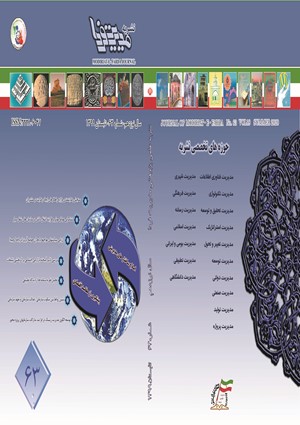(Identification and leveling Factors Affecting the Brand Success of Knowledge-Based Industrial Business( Experimental Examples of Technology Units Deployed at Semnan Province Science and Technology Park(
Subject Areas : مدیریت صنعتی
hasanali Aghajani
1
,
Abdolhamid Safaei Ghadikolaei
2
,
Meysam Shirkhodaei
3
,
hasan vahedi
4
![]()
1 -
2 -
3 -
4 - Assistant Professor, Department of Management, Shahrood Branch, Islamic Azad University, Shahrood, Iran
Keywords: Brand success Knowledge Based Business Interpretive Structural Equations Science and Technology Park,
Abstract :
Abstract Given the importance of brand success in small and medium-sized businesses and especially in knowledge based companies, this research was implemented by goals of identifying and leveling factors affecting the brand success of knowledge based industries in technology units based in the science and technology park of Semnan province using the ISM method. To do this, the views of fourteen university professors and experts of the organizations studied, the factors affecting the brand success of knowledge-based companies were examined and after the final refinement, eight factors were selected. In the next step, these factors were stratified by Structural Interpretation Modeling Technique. Finally, among the factors affecting the brand success of knowledge-based companies, the history of the company and the type of ownership, is first and the most influential factor. Next, brand features are located. The third level includes the market share, the fourth level is the size of the company and the market share and, ultimately, the most influential factors, communications and marketing plans are at the fifth level. This leveling enables knowledge-based companies to formulate the strategies needed to succeed in their product brands and move them closer to their ultimate goal as they progress at each level
.منابع [1]. ادیب، مریم (1391). بررسی تأثیر قیمت و استراتژی اهرم قرار دادن نام تجاری بر نیت خرید مصرف-کنندگان (مورد مطالعه: دسرهای دنت و رامک). دانشکده آموزش¬های الکترونیکی. دانشگاه اصفهان
[2]. اسکندری، ملیحه (1391). تأثیر ارزش ادارک¬شده مشتری بر وفاداری. دانشکده مدیریت و حسابداری. دانشگاه علامه طباطبایی
[3]. امیدوار، مسعود (1392). بررسی تأثیر تبلیغات دهان به دهان الکترونیکی(e-WOM) بر تصویر برند و تمایل خرید خودروی تیبا. دانشکده مدیریت. دانشگاه آزاد اسلامی واحد تهران مرکزی
[4]. سالمی، مهدیه (1394). بررسی تأثیر ارزش و ریسک درکشده سبز بر قصدخرید خودرو به واسطه اعتماد سبز. دانشکده علوم اداری و اقتصاد. دانشگاه فردوسی مشهد
[5]. سرمد، زهره و بازرگان، عباس و حجازي، الهه (1388). روش¬هاي تحقيق در علوم رفتاري، تهران، انتشارات آگاه، چاپ سیزدهم
[6]. سیلک، آلوین جی (1390). بازاریابی. رضوانی، حمیدرضا و شیروانی، امیر. نشر مهربان. چاپ دوم. تهران
[7]. صادق پور، بهرام و مرادی، وهاب ( 1389). تحلیل آماری با نرم افزارهای SPSS و AMOS . بابلسر. انتشارات دانشگاه مازندران
[8]. عطامحمدی، مجتبی (1391).عوامل مؤثر بر انگیزش و قصد خرید مشتریان محصولات نان رضوی (با تأکید بر مارک تجاری). پژوهشکده علوم اجتماعی و اقتصادی. دانشگاه پیام نور استان تهران
[9]. غفاری آشتیانی، پیمان و مشایخی، نسرین و متین راد، امیرحسین (1388). ارزیابی نام و نشان تجاری با کارت ارزیابی. مجله تدبیر، شماره 208، ص 48-44
[10]. سمیعی، محمود. سید مسلم، علوی. مهدی، نجفی.(1392). بررسی عوامل موثر بر موفقیت برند از جانب مشتریان با استفاده از روش تحلیل عاملی. مجله مدیریت بازاریابی.شماره 10.صص24-38
[11]. خیری، بهرام. محمود، سمیعی. محمد، عظیم.(1392). وابستگی عاطفی مصرف کنندگان به بند، پیش نیازها و نتایج. مدیریت بازاریابی. شماره 20.صص11-24
[12]. فرهنگی، علی اکبر. راضیه عابدینی.(1394). تاثیر عانصر آمیخته رسانه بر موفقیت برند خدمات.مجله مدیریت بازاریابی .شماره 26 .صص 17-29
[13]. حسام، مهدی و سید هادی کریمی.(1397). ارزیابی و اولویت بندی مقصد های گردشگری بر اساس ارزش ویژه برند از دیدگاه گردشگران. فصلنامه علمی پژوهشی و بین المللی انجمن جغرافیای ایران، دوره جدید . سال چهاردهم. شماره 49.صص34-49
[14]. Aghekyan-Simonian, M., Forsythe, S., Suk Kwon, W., & Chattaraman, V. (2014). The Role of Product Brand Image and Online Store Image on Perceived Risks and Online Purchase Intentions for Apparel. Journal of Retailing and Consumer Services, 19(3), 325-331. [15]. Chung, M. L., Jhan, H. J., Liou, M. Y., Li, J. S., & Hou, Y. S. (2015). An investigation of Innovation Imitation Products and Consumer Purchases Situational Attribute. Procedia-Social and Behavioral Sciences, 40, 689-694. [16]. García-Villaverde, P. M., Ruiz-Ortega, M. J., & Ignacio Canales, J. (2013). Entrepreneurial orientation and the threat of imitation: The influence of upstream and downstream capabilities. European Management Journal, 31(3), 263-277. [17]. Melnyk, V., Giarratana, M., & Torres, A. (2014). Marking your trade: Cultural factors in the prolongation of trademarks. Journal of Business Research, 67(4), 478-485. [18]. Muhonen .T Laukkanen .T , (2017)," SME Brand identity: Its components, and performance effects ", Journal of Product & Brand Management, Vol. 26 [19]. Odoom R, (2016),"Brand-building efforts in high and low performing small and medium-sized enterprises (SMEs)", Journal of Small Business and Enterprise Development, Vol. 23 Iss 4 pp [20]. Renton, M. Urs Daellenbach Sally Davenport James Richard , (2015),"Small but sophisticated", Journal of Research in Marketing and Entrepreneurship, Vol. 17 Iss 2 pp. 149 - 164 [21]. Shaharudin, M. R., Pani, J. J., Mansor, S. W., & Elias, S. J. (2014). Purchase Intention of Organic Food; Perceived Value Overview. Canadian Social Science, 6(1), 70-79. [22]. Shirazi, A., & Karimi Mazidi, A. (2013). Investigating the Effects of Brand Identity on Customer Loyalty from Social Identity Perspective. Iranian Journal of Management Studies, 6. [23]. Van Horen, F., & Pieters, R. (2013), Preference Reversal for Copycat Brands: Uncertainty Makes Imitation Feel Good. Journal of Economic Psychology, 37 .54–64. http://elsevier.com/ locate/joep. [24]. Yang, M., & Hyland, M. (2016). Similarity in cross-border mergers and acquisitions: Imitation, uncertainty and experience among Chinese firms, 1985–2006. Journal of International Management, 18(4), 352-365. [25]. Tae Hyun Baek. Kim, Jooyoung. Hyunjae Yu,Jay, (2010), The Differential Roles of Brand Credibility and Brand Prestige in Consumer Brand Choice” Psychology & Marketing, Vol. 27(7): 662–678. [26]. Han-MinWang, David. Hua Chen, Pei. Hui-Kuang Yu, Tiffany. Yi Hsiao, Chih. (2015). "The effects of corporate social responsibility on brand equity and firm performance", Journal of Business Research, Volume 68, Issue 11, November 2015, Pages 2232–2236. [27]. Con menictas, paul z.Wang,Jordan j. Louviere, (2012)."Assessing the validity of brand equity constructs”,astralasian markting journal.Elsevier


